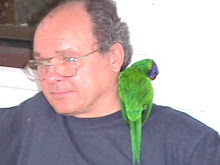
Thankfully the searing heat of the past week finally broke yesterday afternoon when the skies opened up and torrential rain poured down upon the earth. The mornings themselves were glorious [see my previous post] but by around 0600 hours the heat factor was beginning to dominate and by about 0700 hours it was nigh-on impossible to do anything active outdoors – including a gentle stroll to view birds!
As I tap this out on the keyboard it’s a little after 0900 hours on Saturday morning, 30 January 2010, and cloud cover remains; a gentle breeze is blowing with an occasional colder flurry. Far more comfortable than last week’s 30+ temperatures [two days at 40 degrees]. We’ve even managed to plant a row of jacaranda and poinciana trees [to serve as shade for the two dogs- who share a 40x25m compound].
Well, what a difference an hour makes! I’d no sooner written the previous paragraph than a Yellow-tailed Black-Cockatoo came gliding in from behind the west side of the house, heading for the trees on the south, so low I could almost have reached out and touched it!. Sadly, before I could grab my camera, it had disappeared but clearly not too far as Fay and I could still hear it call. We dropped everything, I grabbed the camera [a SONY Alpha 100 with a Minolta AF 100-300 lens, although given the SONY/Minolta combination the focal range is 150-450] and went looking for the bird. At that point a second cockatoo called from the west and again, judging by the call, only a short distance from us.

Fay continued south, I veered to the west. I was perhaps four metres from the bird before I noticed it partly hidden behind a trunk. It took a little careful repositioning to relocate myself into a better angle.
Also in that hour, the sun has escaped from behind the cloud and now [at a little after 1000 hours] it is almost too hot to work outside. The breeze however persists and that keeps temperatures from soaring through the thermometer.
I note that my Year List tally postings don’t quite match up with actual totals. In the past couple of days we’ve added Red-tailed Black-Cockatoo and the Eastern Spinebill to bring the score to 139. For the sake of clarity I attach the complete list as it stands at Saturday 30 January 2010.
The top 5 sightings remain as before.
Apostlebird
Babbler, Grey-crowned
Baza, Pacific
Bittern, Black
Black-Cockatoo, Red-tailed
Black-Cockatoo, Yellow-tailed
Boobook, Southern
Bowerbird, Satin
Brush-turkey, Australian
Bronzewing, Common
Butcherbird, Grey
Butcherbird, Pied
Chough, White-winged
Cicadabird
Cisticola, Golden-headed
Cockatoo, Sulphur-crested
Corella, Little
Cormorant, Great
Cormorant, Little Black
Cormorant, Little Pied
Cormorant, Pied
Coucal, Pheasant
Crow, Torresian
Cuckoo, Black-eared
Cuckoo, Brush
Cuckoo, Channel-billed
Cuckoo, Fan-tailed
Cuckoo-Dove, Brown
Cuckoo-shrike, Black-faced
Cuckoo-shrike, Ground
Currawong, Pied
Dollarbird
Dove, Bar-shouldered
Dove, Emerald
Dove, Peaceful
Dove, Rock
Dove, Spotted
Duck, Australian Wood
Duck, Musk
Duck, Pacific Black
Eagle, Wedge-tailed
Egret, Cattle
Egret, Eastern Great
Egret, Eastern Reef
Egret, Little
Fairy-wren, Red-backed
Fairy-wren, Superb
Fairy-wren, Variegated
Falcon, Peregrine
Fantail, Grey
Figbird, Australasian
Finch, Double-barred
Finch, Red-browed
Flycatcher, Restless
Friarbird, Little
Friarbird, Noisy
Frogmouth, Tawny
Galah
Gerygone, White-throated
Godwit, Bar-tailed
Grassbird, Tawny
Grebe, Australasian
Grebe, Great Crested
Gull, Silver
Hardhead
Heron, White-faced
Heron, White-necked
Hobby, Australian
Honeyeater, Blue-faced
Honeyeater, Brown
Honeyeater, Lewin's
Honeyeater, Scarlet
Honeyeater, Striped
Honeyeater, Yellow-faced
Ibis, Australian White
Ibis, Glossy
Ibis, Straw-necked
Kestrel, Nankeen
Kingfisher, Sacred
King-Parrot, Australian
Kite, Black-shouldered
Kite, Whistling
Koel, Eastern
Kookaburra, Laughing
Lapwing, Masked
Lorikeet, Little
Lorikeet, Rainbow
Lorikeet, Scaly-breasted
Magpie, Austarlian
Magpie-lark
Martin, Fairy
Martin, Tree
Miner, Noisy
Mistletoebird
Monarch, Spectacled
Monarch, White-eared
Moorhen, Dusky
Myna, Common
Needletail, White-throated
Oriole, Olive-backed
Osprey, Eastern
Oystercatcher, Pied
Pardalote, Spotted
Pardalote, Striated
Pelican, Australian
Pigeon, Crested
Pigeon, White-headed
Pigeon, Wonga
Pipit, Australasian
Quail, Brown
Reed-Warbler, Australian
Robin, Eastern Yellow
Rosella, Pale-headed
Scrubwren, White-browed
Sea-eagle, White-bellied
Shrike-thrush, Grey
Silvereye
Sparrow, House
Sparrowhawk, Collared
Spinebill, Eastern
Spoonbill, Yellow-billed
Starling, Common
Stone-curlew, Bush
Swallow, Welcome
Swamphen, Purple
Swan, Black
Teal, Grey
Tern, Crested
Thornbill, Brown
Thornbill, Yellow
Treecreeper, White-throated
Wagtail, Willie
Whipbird, Eastern
Whistler, Golden
Whistler, Rufous
Whistling-Duck, Plumed
Whistling-Duck, Wandering
Woodswallow, Dusky
Woodswallow, White-breasted












